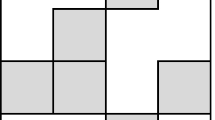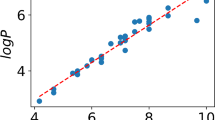Abstract
Among the four methods of the unit-subduced-cycle-index (USCI) approach, the subduced-cycle-index (SCI) method and the partial-cycle-index (PCI) method have been discussed by using adamantane of T d -symmetry as a probe for enumeration problems, where USCIs are derived on the basis of permutaion representations, coset representations (CRs) and marks. After the examination of the SCIs and PCIs, Pólya's theorem that is a standard method of chemical combinatorics has been derived from the USCI approach. As another approach, a new method called the characteristic-monomial (CM) method has been developed by virtue of charactereistic monomials (CMs). The CMs have been derived from Q-conjugacy representations and Q-conjugacy characters, which have been related to irreducible representations and irreducible characters of the standard repertoire of chemical group theory. The two approaches have been compared to discuss group-theoretical tools for chemical combinatorics on a common basis.
Similar content being viewed by others
References
G. Pólya, Compt. Rend. 201 (1935) 1167–1169.
G. Pólya, Helv. Chim. Acta 19 (1936) 22–24.
G. Pólya, Z. Kristal. (A) 93 (1936) 415–443.
G. Pólya, Acta Math. 68 (1937) 145–254.
N.G. de Bruijn, Indag. Math. 21 (1959) 59–69.
D.H. Rouvray, Chem. Soc. Rev. 3 (1974) 355–372.
F. Harary, E.M. Palmer, R.W. Robinson and R.C. Read, in: Chemical Aplications of Graph Theory, ed. A.T. Balaban (Academic Press, London, 1976) pp. 11–24.
K. Balasubramanian, Chem. Rev. 85 (1985) 599–618.
A.T. Balaban (ed.), Chemical Applications of Graph Theory (Academic Press, London, 1976).
G. Pólya, R.E. Tarjan and D.R. Woods, Notes on Introductory Combinatorics (Birkhäuser, Boston, 1983).
G. Pólya and R.C. Read, Combinatorial Enumeration of Groups, Graphs, and Chemical Compounds (Springer, New York, 1987).
J.H. Redfield, Am. J. Math. 49 (1927) 433–455.
J.H. Redfield, J. Graph Theory 8 (1984) 205–223.
R.A. Davidson, J. Am. Chem. Soc. 103 (1981) 312–314.
R.C. Read, J. London Math. Soc. 34 (1959) 417–436.
R.C. Read, J. London Math. Soc. 35 (1960) 344–351.
R.C. Read, Canad. J. Math. 20 (1968) 808–841.
E. Ruch, W. Hässelbarth and B. Richter, Theor. Chim. Acta 19 (1970) 288–300.
E. Ruch and D.J. Klein, Theor. Chim. Acta 63 (1983) 447–472.
W.J. Taylor, J. Chem. Phys. 11 (1943) 532.
T.L. Hill, J. Chem. Phys. 11 (1943) 294–297.
D.H. McDaniel, Inorg. Chem. 11 (1972) 2678–2682.
J.E. Leonard, J. Phys. Chem. 81 (1977) 2212–2214.
J.R.L. Flurry, J. Chem. Educ. 61 (1984) 663.
J. Sheehan, Canad. J. Math. 20 (1968) 1068–1076.
A. Kerber and K.-J. Thürlings, in: Combinatorial Theory, eds. D. Jngnickel and K. Vedder (Springer, Berlin, 1982) pp. 191–211.
W. Hässelbarth, Theor. Chim. Acta 67 (1985) 339–367.
J. Brocas, J. Am. Chem. Soc. 108 (1986) 1135–1145.
C.A. Mead, J. Am. Chem. Soc. 109 (1987) 2130–2137.
E.K. Lloyd, J. Math. Chem. 11 (1992) 207–222.
W. Burnside, Theory of Groups of Finite Order, 2nd ed. (Cambridge University Press, Cambridge, 1911).
J.A. Pople, J. Am. Chem. Soc. 102 (1980) 4615.
S. Fujita, Theor. Chim. Acta 76 (1989) 247–268.
S. Fujita, J. Am. Chem. Soc. 112 (1990) 3390–3397.
S. Fujita, Symmetry and Combinatorial Enumeration in Chemistry (Springer, Berlin, 1991).
S. Fujita, J. Math. Chem. 12 (1993) 173–195.
S. Fujita, Theor. Chim. Acta 82 (1992) 473–498.
S. Fujita, J. Math. Chem. 5 (1990) 99–120.
S. Fujita, Theor. Chem. Acta 91 (1995) 291–314.
S. Fujita, Theor. Chem. Acta 91 (1995) 315–332.
A. Streitwieser Jr., Molecular Orbital Theory for Organic Chemists (Wiley, New York, 1961).
B.S. Tsukerblat, Group Theory in Chemistry and Spectroscopy (Academic Press, London, 1994).
I. Hargittai and H. Hargittai, Symmetry through the Eyes of a Chemist (VCH, Weinheim, 1986).
F.A. Cotton, Chemical Applications of Group Theory (Wiley, New York, 1971).
H.H. Jaffé and M. Orchin, Symmetry in Chemistry (Wiley, Chichester, 1965).
L.H. Hall, Group Theory and Symmetry in Chemistry (McGraw-Hill, New York, 1969).
D.M. Bishop, Group Theory and Chemistry (Clarendon, Oxford, 1973).
S.F.A. Kettle, Symmetry and Structure (Wiley, Chichester, 1985).
M.F.C. Ladd, Symmetry in Molecules and Crystals (Ellis Horwood, Chichester, 1989).
D.C. Harris and M.D. Bertolucci, Symmetry and Spectroscopy (Dover, New York, 1989).
S. Fujita, Theor. Chem. Acc. 99 (1998) 224–230.
S. Fujita, Bull. Chem. Soc. Jpn. 72 (1999) 13–20.
S. Fujita, Theor. Chem. Acc. 101 (1999) 409–420.
S. Fujita, Bull. Chem. Soc. Jpn. 63 (1990) 315–327.
S. Fujita, Bull. Chem. Soc. Jpn. 71 (1998) 1587–1596.
S. Fujita, Bull. Chem. Soc. Jpn. 71 (1998) 2071–2080.
S. Fujita, Bull. Chem. Soc. Jpn. 71 (1998) 2309–2321.
S. Fujita, unpublished results.
C.W. Curtis and I. Reiner, Representation Theory of Finite Groups and Associative Algebras (Wiley, New York, 1962).
S. Fujita, Theor. Chem. Acc. 99 (1998) 404–410.
Author information
Authors and Affiliations
Rights and permissions
About this article
Cite this article
Fujita, S. The Unit-Subduced-Cycle-Index Methods and the Characteristic-Monomial Method. Their Relationship as Group-Theoretical Tools for Chemical Combinatorics. Journal of Mathematical Chemistry 30, 249–270 (2001). https://doi.org/10.1023/A:1015166625910
Issue Date:
DOI: https://doi.org/10.1023/A:1015166625910




